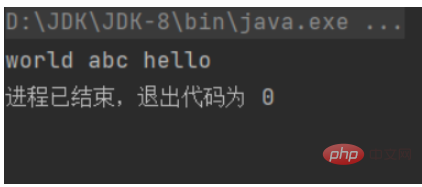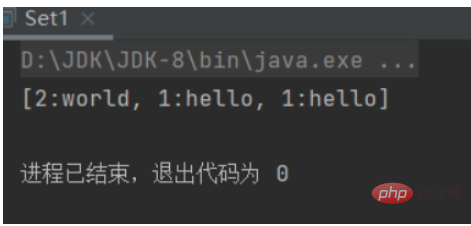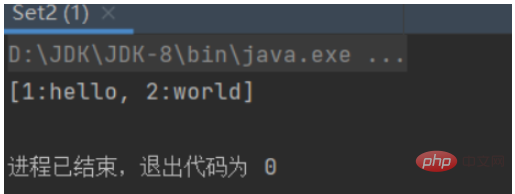Java에서 Set 인터페이스를 사용하여 중복 요소 없이 배열을 저장하는 방법
Set 인터페이스
Set 인터페이스는 List 인터페이스와 마찬가지로 Collection 인터페이스를 상속합니다. Set 인터페이스의 요소는 순서가 없으며 저장된 요소가 반복되지 않도록 특정 규칙이 사용됩니다.
HashSet 컬렉션
HashSet은 Set 인터페이스의 구현 클래스입니다. 저장된 요소는 반복되지 않으며 요소는 순서가 지정되지 않습니다. HashSet 컬렉션에 개체를 추가하면 개체의 hashCode()가 먼저 호출됩니다. ) 객체의 해시 값을 계산하여 요소의 저장 위치를 결정하는 메서드입니다. 이때 해시 값이 동일하면 객체의 equals() 메서드를 호출하여 이 위치에 중복된 요소가 없는지 확인합니다.
package 集合类;
import java.util.HashSet;
import java.util.Iterator;
public class Set {
public static void main(String[] args) {
HashSet set=new HashSet();
set.add("hello");
set.add("world");
set.add("abc");
set.add("hello");
Iterator it=set.iterator();
while(it.hasNext()){
Object obj=it.next();
System.out.print(obj+ " ");
}
}
}실행 결과

실행 결과를 보면 요소 제거 순서와 요소 추가 순서가 일치하지 않으며, 반복되는 문자열은 제거되고 add( 때문에 한 번만 추가되는 것을 볼 수 있습니다. HashSet 컬렉션) 메서드를 사용하여 요소를 저장하려면 먼저 현재 저장된 객체의 hashCode() 메서드를 호출하여 해당 객체의 해시 값을 얻은 다음 해당 해시 값을 기준으로 저장 위치를 계산합니다. 이 위치에 요소를 직접 저장합니다. 이 위치에 요소가 있는 경우 현재 저장된 요소와 이 위치의 요소를 비교하기 위해 equal() 메서드가 호출됩니다. 반환 결과가 false인 경우 해당 요소는 컬렉션에 저장됩니다. 반환 결과가 true인 경우 중복된 요소가 있음을 의미하며 해당 요소는 삭제됩니다.
package 集合类;
import java.util.HashSet;
class Student{
String id;
String name;
public Student(String id,String name){
this.id=id;
this.name=name;
}
public String toString(){
String s = id + ":" + name;
return s;
}
}
public class Set1 {
public static void main(String[] args) {
HashSet hs=new HashSet();
Student stu1=new Student("1","hello");
Student stu2=new Student("2","world");
Student stu3=new Student("1","hello");
hs.add(stu1);
hs.add(stu2);
hs.add(stu3);
System.out.println(hs);
}
}실행 결과

Student 클래스를 정의할 때 hashCode() 및 equals() 메서드가 재정의되지 않으므로 중복된 요소는 제거되지 않습니다.
package API;
import java.util.HashSet;
class Student{
private String id;
private String name;
public Student(String id,String name){
this.id=id;
this.name=name;
}
//重写toString方法
public String toString(){
return id+ ":"+name;
}
//重写hashCode方法
public int hashCode(){
//返回id属性的哈希值
return id.hashCode();
}
public boolean equals(Object obj){
//判断是否是同一个对象
if(this==obj){
return true;
}
//判断对象是Student类型
if(!(obj instanceof Student)){
return false;
}
//将对象强转为Student类型
Student stu=(Student) obj;
//判断id是否相同
boolean b=this.id.equals(stu.id);
return b;
}
}
public class Set2 {
public static void main(String[] args) {
HashSet hs=new HashSet();
Student stu1=new Student("1","hello");
Student stu2=new Student("2","world");
Student stu3=new Student("1","hello");
hs.add(stu1);
hs.add(stu2);
hs.add(stu3);
System.out.println(hs);
}
}실행 결과
Student 클래스가 Object 클래스의 hashCode() 및 equals() 메서드를 재정의하기 때문입니다. hashCode() 메서드에서 id 속성의 해시 값을 반환하고, equals() 메서드에서 객체의 id 속성이 동일한지 비교하여 결과를 반환합니다. stu3 객체를 추가하기 위해 HashSet 컬렉션의 add() 메서드를 호출하면 해당 해시 값이 stu2 객체와 동일하고 stu2.equals(stu3)가 true를 반환하는 것으로 나타났습니다. HashSet은 두 개체가 동일하다고 판단하여 중복된 Student 개체가 제거됩니다.

위 내용은 Java에서 Set 인터페이스를 사용하여 중복 요소 없이 배열을 저장하는 방법의 상세 내용입니다. 자세한 내용은 PHP 중국어 웹사이트의 기타 관련 기사를 참조하세요!

핫 AI 도구

Undresser.AI Undress
사실적인 누드 사진을 만들기 위한 AI 기반 앱

AI Clothes Remover
사진에서 옷을 제거하는 온라인 AI 도구입니다.

Undress AI Tool
무료로 이미지를 벗다

Clothoff.io
AI 옷 제거제

AI Hentai Generator
AI Hentai를 무료로 생성하십시오.

인기 기사

뜨거운 도구

메모장++7.3.1
사용하기 쉬운 무료 코드 편집기

SublimeText3 중국어 버전
중국어 버전, 사용하기 매우 쉽습니다.

스튜디오 13.0.1 보내기
강력한 PHP 통합 개발 환경

드림위버 CS6
시각적 웹 개발 도구

SublimeText3 Mac 버전
신 수준의 코드 편집 소프트웨어(SublimeText3)

뜨거운 주제
 7318
7318
 9
9
 1625
1625
 14
14
 1349
1349
 46
46
 1261
1261
 25
25
 1209
1209
 29
29
 Java의 난수 생성기
Aug 30, 2024 pm 04:27 PM
Java의 난수 생성기
Aug 30, 2024 pm 04:27 PM
Java의 난수 생성기 안내. 여기서는 예제를 통해 Java의 함수와 예제를 통해 두 가지 다른 생성기에 대해 설명합니다.
 자바의 웨카
Aug 30, 2024 pm 04:28 PM
자바의 웨카
Aug 30, 2024 pm 04:28 PM
Java의 Weka 가이드. 여기에서는 소개, weka java 사용 방법, 플랫폼 유형 및 장점을 예제와 함께 설명합니다.
 자바의 암스트롱 번호
Aug 30, 2024 pm 04:26 PM
자바의 암스트롱 번호
Aug 30, 2024 pm 04:26 PM
자바의 암스트롱 번호 안내 여기에서는 일부 코드와 함께 Java의 Armstrong 번호에 대한 소개를 논의합니다.
 Java의 스미스 번호
Aug 30, 2024 pm 04:28 PM
Java의 스미스 번호
Aug 30, 2024 pm 04:28 PM
Java의 Smith Number 가이드. 여기서는 정의, Java에서 스미스 번호를 확인하는 방법에 대해 논의합니다. 코드 구현의 예.
 Java Spring 인터뷰 질문
Aug 30, 2024 pm 04:29 PM
Java Spring 인터뷰 질문
Aug 30, 2024 pm 04:29 PM
이 기사에서는 가장 많이 묻는 Java Spring 면접 질문과 자세한 답변을 보관했습니다. 그래야 면접에 합격할 수 있습니다.
 Java 8 Stream foreach에서 나누거나 돌아 오시겠습니까?
Feb 07, 2025 pm 12:09 PM
Java 8 Stream foreach에서 나누거나 돌아 오시겠습니까?
Feb 07, 2025 pm 12:09 PM
Java 8은 스트림 API를 소개하여 데이터 컬렉션을 처리하는 강력하고 표현적인 방법을 제공합니다. 그러나 스트림을 사용할 때 일반적인 질문은 다음과 같은 것입니다. 기존 루프는 조기 중단 또는 반환을 허용하지만 스트림의 Foreach 메소드는이 방법을 직접 지원하지 않습니다. 이 기사는 이유를 설명하고 스트림 처리 시스템에서 조기 종료를 구현하기위한 대체 방법을 탐색합니다. 추가 읽기 : Java Stream API 개선 스트림 foreach를 이해하십시오 Foreach 메소드는 스트림의 각 요소에서 하나의 작업을 수행하는 터미널 작동입니다. 디자인 의도입니다






